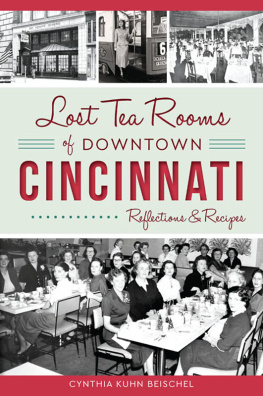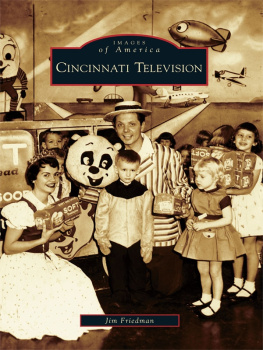

Published by American Palate
A Division of The History Press
Charleston, SC
www.historypress.net
Copyright 2016 by Cynthia Kuhn Beischel
All rights reserved
Front cover, top center: A woman disembarking the trolley. Photograph by the author; courtesy of the Cincinnati Museum Center at Union Terminal.
First published 2016
e-book edition 2016
ISBN 978.1.43965.852.9
Library of Congress Control Number: 2016943915
print edition ISBN 978.1.46713.727.0
Notice: The information in this book is true and complete to the best of our knowledge. It is offered without guarantee on the part of the author or The History Press. The author and The History Press disclaim all liability in connection with the use of this book.
All rights reserved. No part of this book may be reproduced or transmitted in any form whatsoever without prior written permission from the publisher except in the case of brief quotations embodied in critical articles and reviews.
This book is dedicated to all the girls and women in my life.
May all the wonderful memories that resurfaced and became a part of this book become the inspiration for a resurgence of polite manners, consideration and a sense of loyalty for others.
Contents
Flashback
Snapshot of the Past
It was such a different world. Downtown was really something. Downtown was a totally different environment than it is now. Downtown is gone. Those were the good old days. The pace was slower, more leisurely. It was more elegant. There was a sense of occasion to going downtown. It was a magical time to go to town.
These sentiments are typical of the comments expressed repeatedly during interviews. What was so different?
Consider that around 1930, almost a fifth of all the people who lived in Cincinnati walked by the intersection of Fifth and Vine Streets every day. Downtown in those days had a high volume of traffic and was described as a vibrant and interesting place to be in the 1930s, 40s and 50s. There was always a feeling of excitement about going downtownthere were so many things to see and do. Banks, doctors, pharmacies, lawyers, accountants, investment brokers, barbers, beauty shops, tailors, dressmakers and myriad other destinations, including the department stores, drew people to the citys business center. The era of looking at a shopping trip downtown as a destination continued into the early 1970s. There was a special spirit to those times. People made an effort to get all dressed up for these expeditionsdoing so was part of the adventure.
Of course people got dressed up to go downtown. Downtown was where you would be seen and see others. Men wore business suits, and many wore fedoras; boys wore blazers and ties. Women never thought about wearing slacks (pants for those who are too young to recognize that word) before the 1970s and certainly nothing resembling blue jeans. To do so would have been shocking! Disgraceful! To be properly dressed as ladies, girls wore their Sunday best (including black patent-leather shoes, kept glossy with Vaseline) and women wore dresses or skirts, stockings (in some years with seams along the back of the leg and held up by girdles or garter belts), heels, perhaps a strand of pearls around the neck and, of course, hats and the ever-mentioned white cotton gloves that were required by etiquette and the fashion standards of the past. There were decades when gloves were worn throughout the day, except while eating (you would have slipped them into your purse after being seated) or to assess the feel of fabrics. While gloves continued to be popular, hats began to go out of favor with younger women in the 1960s, for the most part due to the new bouffant and beehive hairstyles. By the 1970s, people still got dressed up, but both hats and gloves were no longer in style.
The art of buying gloves was far more complex than just grabbing a pair marked small, medium or large from a rack. The salesladies were taught to perform a series of actions and steps to achieve a perfect fit for the customer. The customer placed her arm on the counter with her elbow bent and hand pointing upward. The saleslady would then size and fit the glove to her hand, smoothing the fabric down and around each finger.
Keeping white cotton gloves clean was a difficult task. On a trip downtown with your white gloves on and your ten- or fifteen-cent fare in hand, by the time you got on the streetcar, put your money in the box and held onto the pole or strap if no seats were available, your gloves would be soiled. This was especially true in the war years, when the factories were running around the clock and Cincinnati was a fairly filthy place. Even with the best attempts to carefully wash the gloves so as to always have clean, pretty, white pairs, many women stated that it was very difficult to remove that last little bit of dark stain out of the fingertips. Many found it convenient to have three or four pairs for rotation.
The hosiery department definitely offered a more elegant buying experience than the current way hose are sold. Silk stockings and nylons were kept behind glass counters in flat, thin boxes that would indicate the size and shade of color on the edge. A saleslady would use her long, polished fingernails to get underneath the lid, hook the box and slide it out from the stack on the shelf. She would then open up the box, unfold the tissue wrapper and slip her hand inside the top of the stocking, beyond the dark band, so the customer could see the actual color. Women wearing rings were not allowed to do that, for fear of snags. In contrast, on the bargain tables of nylons in the basements of some stores, the stockings were loose and all mixed up. Customers picked through them, trying to match the stockings both in size and color, and flung the chosen ones over their shoulders to keep them separate from the pile. At least once, a woman was seen walking out of the store with a stocking or two still on her shoulder!
Until the early 1960s, elevators were not automatic, as they are now. Instead, they were run usually by women wearing uniforms with epaulets similar to those worn by hotel bellhops. When the elevators arrived on the main floor, an operator stood by the door with a pointer and tapped on the frame indicating that hers would be going up next. Inside the elevator, the operator stood to the side, just inside the door, although there was a fold-down seat for her use if she got tired of standing. First, she closed the folding metal cage gate and then the main door, before turning the dial or lever to make the elevator move. As each floor approached, she announced the floor number and what could be found on each level. Third FloorLadies Dresses and Coats, Lingerie, Girls Clothing and Accessories, Infants and Toddlers Shop, Fashion Fabrics and Sewing Machines, Beauty Salon. The stops were usually a bit jerky, sometimes taking a few attempts at alignment. Hitting the exact spot required some practice and expertise.
Store hours were limited in the bygone days. Most department stores were open starting from 9:30 or 10:00 a.m. until 5:00 or 5:30 p.m., with Monday night hours stretching to 8:30 p.m. In the mid-1950s, many stores extended their hours to also include Thursday evenings. In general, most businesses were closed in the evenings, as they were on Sundays (remember when blue laws were in place and prohibited shopping on the Christian Sabbath?) and major holidays. On Good Fridays, everything was closed from noon to 3:00 p.m.
Next page







